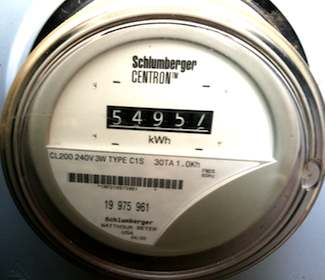Net Metering

Net Metering - Turn Your Electric Meter Backwards
Renewable energy is becoming more popular every year as advances in technology and efficiencies continue, as well as decreasing costs. The cost of residential renewable energy, in the form of solar or wind power, is still rather high for the average homeowner. This, too, is changing quickly. Gone are the days of going 100% 'Off the Grid', replacing all of a home's power with renewable power and disconnecting from the utilities.
Today, homeowners can rather easily convert a portion of their home's energy usage to renewable; the benefits of a gradual switch to renewable are plentiful. Homeowners can start with a smaller renewable energy system, keeping the costs within budget. Keeping the home connected to the utility grid means a large investment in batteries is not needed, and the home will still have the constant supply of power the utilities can provide.
Affordable residential renewable energy is made possible by decreased manufacturing costs, the availability of energy tax credits and rebates, and also the concept of Net Metering.
Net Metering: Make Your Home a Power Plant
Net metering is an innovative policy offered to consumers who have some type of renewable energy system. The concept is simple; the home's renewable energy system creates power from the sun or wind that is used as needed by the household. If the house is requiring more energy than the renewable can create at a certain time, power from the utilities will be used to pick up the slack.
The 'net' part of net metering is where things get interesting; if your home's renewable energy system is generating more power than it is using (for example, during the middle of a sunny workday), that excess energy is sent back into the grid, and the homeowner becomes basically an energy supplier to the utility company. The result; the amount of energy sent to the grid is deducted from the home's overall power bill at the end of the month. It becomes possible, with enough efficiency in the home and ample renewable energy, to actually receive a check from the power company rather than sending one to them.
How Net Metering Works
In the U.S., the Energy Policy of 2005 requires all public utilities to make net metering available to all of their customers that request it.
Most net metering programs require electricity meters that record electricity usage in both directions, ingoing and outgoing. This provides a way to accurately record the home's electricity usage and production for future credit.
The method and requirements for residential net metering varies by utility company. The amount of refund the utility companies will provide back to the homeowner can also vary; some companies have a cap on how much money they will pay back to the homeowner.
Types of Net Metering:
Time of Use Metering: Time of use (TOU) net metering uses a reversible smart meter programmed to determine the home's electricity usage at any time of the day. TOU allows rates and charges to be charged based on when the electricity is used (day vs. night). Usage during the day is typically charged at a higher rate due to the higher demand during peak usage hours, and vice versa at night.
Market Rate Net Metering: With a market rate net metering program, the home's energy use is priced based on current wholesale electricity prices. In this type of system, the electricity sold back to the utility must be equal to the price charged for power at the same time, and can never be negative. This means you can't make money from selling more money back to the utility than you're using. This is controversial in some renewable energy circles, since the excess power your home creates is in effect given away for free to the power company.
If you are a homeowner with an interest in reducing your home's environmental impact by installing a renewable energy system, contact your local electric utility to find out about their net metering program.
For information on energy tax credits, see our articles here.
Energy Tax Credits
Solar Hot Water Credit for Roofing, Water Heaters, Doors and Skylights
Energy Tax Credits 2011 Wind Energy
Federal Energy Tax Credit
Solar Hot Water Rebate


























































































































































































